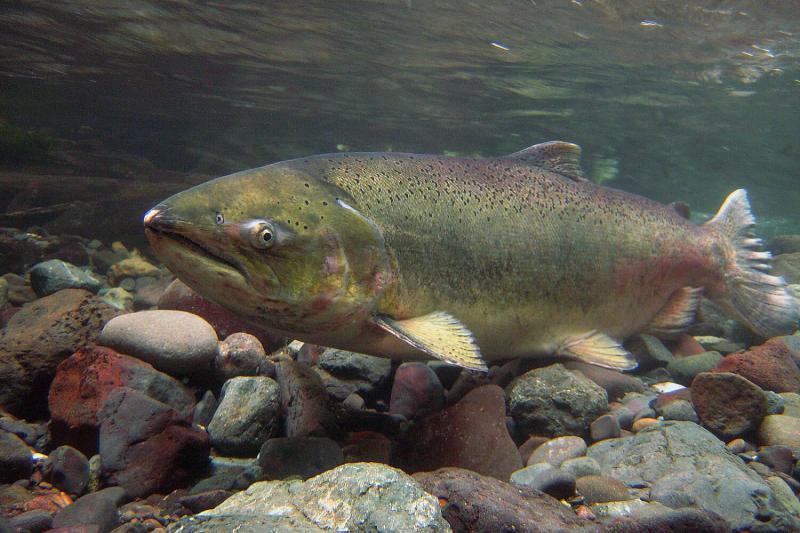
The Elwha River restoration: A case study in adaptive management for salmon recovery
by NOAA Fisheries 16 Sep 2024 21:20 UTC

Female Chinook Salmon guarding her nest © NOAA Fisheries
Elwha River restoration project offers valuable insights into the complex ecological processes involved in dam removal and river recovery.
Removing the Elwha and Glines Canyon dams on Washington's Elwha River presented an opportunity to study the ecological response of a river ecosystem to large-scale disturbance and subsequent restoration. Central to this effort was the development and implementation of an adaptive management framework aimed at guiding the recovery of Chinook salmon and steelhead trout populations. Extensive monitoring showed that removing the dams positively impacted Chinook salmon and steelhead populations and improved the ecological condition of the river. These results were published in the special issue "Large-Scale Dam Removal and Ecosystem Restoration" of Frontiers.
Elwha River Dam Removals
The Elwha River, once renowned for its robust salmon runs, experienced significant ecological degradation following the construction of the two dams in the early 20th century. These structures impeded fish migration, altered hydrological regimes, and trapped sediment, leading to a precipitous decline in salmon populations. Decades of advocacy culminated in the Elwha River Ecosystem and Fisheries Restoration Act of 1992, enabling dam removal, which occurred in phases from 2011 to 2014.
Adaptive Management Framework
Adaptive management is a systematic approach to environmental and conservation management. It involves learning from outcomes, adjusting strategies based on new information, and promoting continuous improvement.
Scientists from federal and state agencies and the Lower Elwha Klallam Tribe established the Elwha Monitoring and Adaptive Management guidelines. They aid in the recovery of endangered Chinook salmon and steelhead trout populations. This framework incorporated a phased approach, with distinct recovery objectives and performance indicators for each of the four recovery phases:
- Preservation
- Recolonization
- Local adaptation
- Viable natural population
They also emphasized the importance of monitoring key physical and biological parameters to inform management decisions.
Key Findings and Challenges
The agency partners and the Tribe implemented a comprehensive monitoring program to track changes in fish populations, habitat conditions, and water quality. These data were used to assess progress toward recovery goals and identify potential management adjustments.
For the past decade, the partners and Tribe have monitored the Elwha ecosystem. Here's some of what they've learned:
Salmon Response
Chinook salmon populations exhibited signs of recovery, with increases in abundance and distribution. However, adult productivity remained below target levels. Steelhead trout demonstrated more rapid recovery, with populations exceeding reintroduction phase targets.
Monitoring Effectiveness
The monitoring program successfully provided critical data for informing management decisions. However, challenges related to data collection and analysis were encountered, particularly with juvenile fish abundance estimates.
Adaptive Management Implementation
Adapting management actions based on monitoring results was complex due to multiple agencies with varying authorities and responsibilities. Additionally, the legal framework, particularly the Endangered Species Act, imposed regulatory requirements on management and monitoring activities.
Performance Indicator Challenges
Defining and measuring appropriate performance indicators proved challenging—some initial methods and metrics worked well, but others did not. The monitoring adapted by shifting resources towards the biological indicators that proved most effective for assessing the impacts of dam removal and restoration of the overall ecosystem.
Salmon Recovery and Sediment Dynamics
Early results from the monitoring program demonstrate that removing the two large Elwha River dams has positively impacted Chinook salmon and steelhead populations. Combined with hatchery management actions and harvest restrictions, researchers found that dam removal led to:
- Increased adult fish numbers
- Expanded habitat use
- A resurgence of naturally produced juvenile salmon
The removal of the Elwha dams initiated a dramatic transformation of the river's sediment regime. Vast quantities of sediment, previously trapped behind the dams, were released, reshaping the riverbed and creating new habitats. This process was initially disruptive to salmon populations. However, once the short-term sediment disturbance was replaced with a more stable natural sediment regime, it improved the ecological condition of river reaches in the former reservoirs and downstream.
Sediment is crucial for salmon spawning and rearing. It provides the substrate for redds, the nests where salmon bury their eggs. Additionally, sediment helps to create diverse aquatic habitats that support a variety of aquatic insects, the primary food source for juvenile salmon.
Hatchery Role and Genetic Considerations
To mitigate the risks associated with dams and later dam removal, the partners implemented hatchery programs for natural salmon populations before, during, and after dam removal. While hatcheries have played a role in maintaining initial salmon numbers, the monitoring guidelines calls for long-term reductions in hatchery production.
Re-Emergence of Summer Steelhead
A particularly promising development in the Elwha River restoration is the re-emergence of summer steelhead. This life history strategy, once thought to be lost due to the dams, has rebounded. It demonstrates the remarkable adaptability of these fish and the importance of providing diverse habitats to support various fish life histories.
While the early results of the Elwha River dam removal project are encouraging, it is important to emphasize that the river's recovery is a long-term process. It will take decades for the ecosystem, including salmon and steelhead populations, to rebound fully.
The Elwha River restoration project offers valuable insights into the complex ecological processes involved in dam removal and river recovery. While challenges remain, the project has demonstrated the potential for large-scale ecosystem restoration. It also highlighted the importance of collaborative partnerships and adaptive management in guiding such complex endeavors. Federal and state agencies involved in this effort:
- NOAA Fisheries
- U.S. Department of Fish and Wildlife Service
- U.S. Geological Survey
- Washington Department of Fish and Wildlife
- National Park Service
Carefully monitoring the river's response and adapting management strategies allows scientists and managers to learn from the Elwha River experience and apply these lessons to future restoration efforts. The ultimate goal is to restore salmon population abundance and diversity, ensuring the long-term health and resilience of the Elwha River ecosystem.